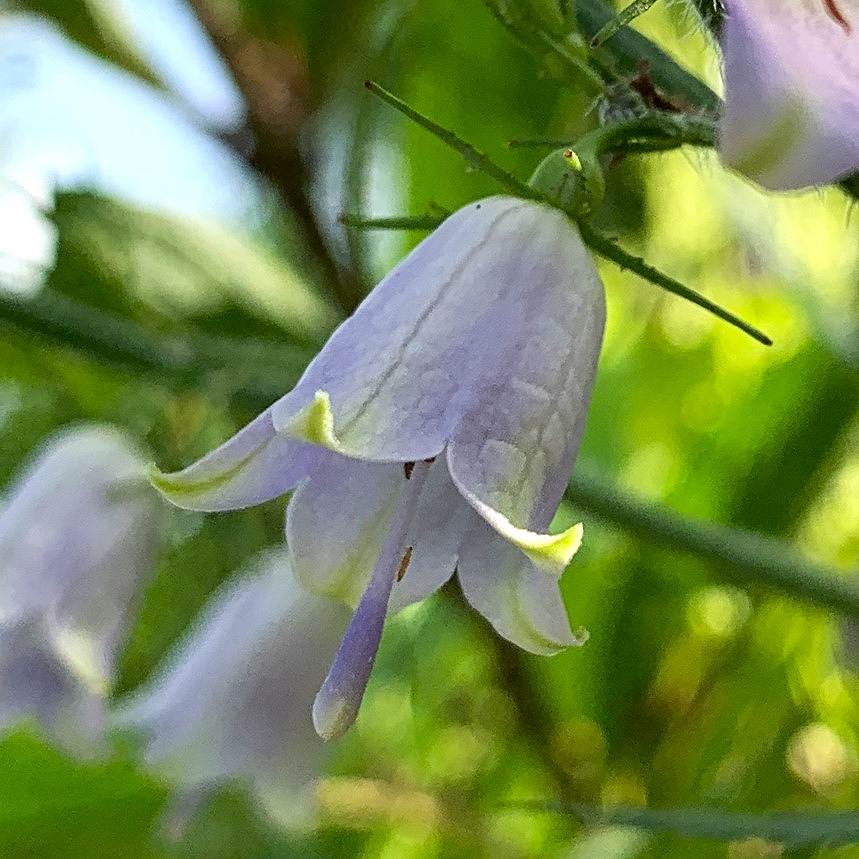ツリガネニンジンの花は風に揺れると音が鳴りそうな釣鐘形。下を向いて輪生し、花冠が浅く5裂、雄しべが5本、雌しべが長く突き出ます。
Ladybells flowers are bell-shaped, and when they sway in the wind, they seem to ring at any moment. It blooms facing downwards around the stem, with a shallow 5-lobed corolla, 5 stamens, and long protruding pistils.
【仮名】ツリガネニンジン
【和名】釣鐘人参
【英名】Ladybells
【学名】Adenophora triphylla
【誕生】10/ 04, 10/ 27
【開花】08, 09, 10月
【花色】White, Violet



ツリガネニンジン
ツリガネニンジンの生態
ツリガネニンジンはキキョウ科の多年草です。日本では北海道から本州、四国、九州まで、国外では樺太から朝鮮半島、中国まで分布。漢名「沙参」は「水辺の砂地に生える人参」という意味ですが、山野から林縁、河川敷まで、日当たりと水はけの良いところなら何処でも育ちます。
ツリガネニンジンの名前
ツリガネニンジンの和名の由来は、花が釣鐘のような形で、根が薬用の「御種人蔘」に似ているからです。ラテン語の属名アデノフォーラは「腺がある」という意味で、茎葉を傷つけると乳液が出るから。種名トリフィラは「3枚の葉」という意味で、茎に輪生する葉を表しています。
ツリガネニンジンの姿形
ツリガネニンジンの茎は分枝せず、真っ直ぐ伸びます。葉は変化に富んで輪生・互生・対生し、形も丸形から披針形まで。花は下を向いて輪生し、花冠が浅く5裂、雄しべが5本、雌しべが長く突き出ます。花後は蒴果を結び、茎に釣り下がったまま裂開。種子を少しずつ落とします。
ツリガネニンジンの近縁
ツリガネニンジンは変種が多く、西日本では本州の中国地方以西に「細葉沙参」、四国の一部に「乙女沙参」が自生しています。東日本では本州の中部地方以北に「白山沙参」「岩沙参」「福島沙参」が自生。そのほか、同種の「白花釣鐘人参」、同属の「岨菜」も形状が似ています。
ツリガネニンジンの利用
ツリガネニンジンの白く肥大した根茎は、掘り上げて天日に干し、漢方の生薬「沙参」または「南沙参」として鎮咳、去痰、健胃、強壮などに用いられます。一方、春の若芽は昔から「ととき」と呼ばれ、和え物やお浸しなどに。根茎もキンピラ、粕漬けなどで美味しく食べられます。
Ladybells
Ladybells is a perennial plant of the Campanulaceae family. In Japan, it is distributed from Hokkaido to Honshu, Shikoku, and Kyushu, and overseas from Sakhalin to the Korean Peninsula and China. The Chinese name “shashen” means “ginseng that grows on the sandy ground near the water”, but it grows anywhere from mountains and fields to the edge of forests and riverbeds, as long as it is sunny and well-drained.
The origin of “Bell Ginseng”, Japanese name of Ladybells, is that the flower is shaped like a bell and the root resembles the medicinal “Ginseng”. The genus name Adenophora in Latin means “glandular” because it produces a milky sap when the foliage is damaged. The species name Triphylla means “three leaves”, referring to the whorled leaves on the stem.
The stalk of Ladybells is unbranched and grows straight. The leaves are rich in variety, whorled, alternate, and opposite, and the shape ranges from round to lanceolate. The flowers are whorled downward, with a shallow 5-lobed corolla, 5 stamens, and long protruding pistils. After flowering, it bears a capsule and dehiscences while hanging from the stem. Gradually drop the seeds.
There are many varieties of Ladybells, and in western Japan, “triphylla” grows wild in the Chugoku region of Honshu and westward, and “puellaris” grows naturally in a part of Shikoku. In eastern Japan, “hakusanensis”, “takedae” and “divaricata” grow wild north of the Chubu region of Honshu. In addition, “albiflora” of the same species and “remotiflora” of the same genus have also similar shapes.
The white, swollen rhizomes of Ladybells are dug up and dried in the sun, and are used as a herbal medicine “Shashen” or “Nan Shashen” for cough suppressant, expectorant, stomachic, and tonic. On the other hand, young shoots in spring have been called “totoki” since ancient times, and are used in dressed and boiled. The rhizome can also be eaten deliciously with kinpira and pickled sake lees.


